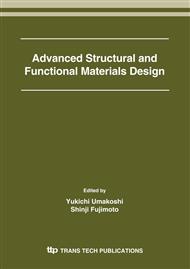p.269
p.281
p.289
p.295
p.301
p.305
p.309
p.313
p.319
Convection in Weld Pool under Microgravity and Terrestrial Conditions
Abstract:
Electron beam (EB) welding and tungsten inert gas (TIG) welding were performed under both microgravity and terrestrial conditions in order to investigate the effects of gravity and surface tension on the convection in a molten pool. The microgravity conditions were achieved using the drop-shaft at the Japan Microgravity Center (JAMIC). A small-sized EB or TIG welding system was loaded into the drop capsule, and then the capsule was dropped 710m below ground level. The system attains a microgravity level of 10-5 G for a duration of 10 seconds. Pure iron and an iron-tungsten alloy (SKD4) were used for the iron samples, while pure aluminum and an aluminum-copper alloy (A2219) were used for the aluminum samples. The cross sections of the specimens were analyzed by EPMA after the welding to investigate the distribution of the minor elements. During the EB welding, the surface tension and the buoyancy determine the convection. Under microgravity, only the surface tension causes the convection because the buoyancy is considered to be negligible. As a result, it was found that the convection due to the surface tension is dominant for the iron alloys, but it is very weak for the aluminum alloys.
Info:
Periodical:
Pages:
301-304
Citation:
Online since:
April 2006
Authors:
Price:
Сopyright:
© 2006 Trans Tech Publications Ltd. All Rights Reserved
Share:
Citation:


